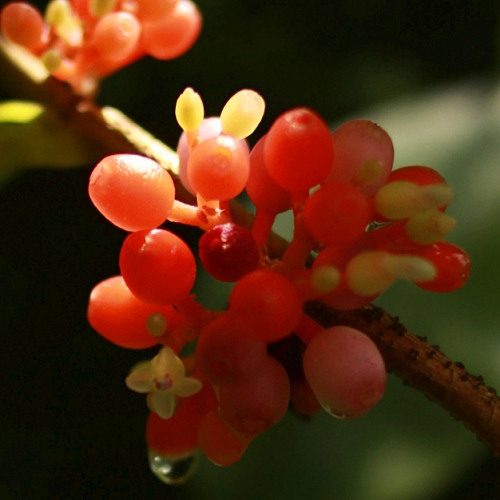Germinating the seeds
When to plant - Plant them when you receive them for best results. Soil --
For soil, use a well draining mix high in organic matter. A typical mix is
2 parts potting soil to 1 part
perlite Pot size - Use small pots, or cups with drainage holes, about 2 to 3 inches tall (5-7 cm). Fill the pots with the soil mix and water it until it is evenly moist (but not soggy). Place a seed or 2 on top.
Next add water until everything is evenly moist (but not soggy). Until the seeds sprout, it's important not to let the soil surface dry out. It may be best to enclose the pots in a plastic container or bag to maintain moisture. Just leave it open slightly to allow some fresh air in. You may need to drip a few drops of water on the surface one or more times a day to keep it moist. Aim to keep the seeds between 66 and 81° F (19-27°C) day & night. I have no information about how well they germinate outside that temperature range. I recommend placing a minimum/maximum thermometer near the pots, especially if using a heating mat. Keep them in a bright spot out of direct sun. A fluorescent bulb kept 4 inches (10 cm) away provides the right amount of light. They should begin sprouting in 6 weeks, but allow up to 12 weeks for any slow ones, especially at cooler temperatures. The seedlings are small when they sprout, and they grow slowly, so they require close monitoring the first few 2-3 months, to ensure they are not neglected. Lighting -- After they sprout, keep them in a bright spot, with protection from afternoon sun. Watering: After the seedlings are 5 weeks old, you may allow the soil surface to dry out between waterings, but aim to keep the rest of the soil evenly moist most of the time. Never let it dry out completely, but also avoid keeping it constantly soggy. If your water supply is very high in minerals (= "hard water"), it's best to use bottled water or rainwater. Fertilizing -- For the 3 months, feed every 2 weeks with a small amount of dilute (1/8 strength) liquid fertilizer. Hydroponic fertilizer is ideal for young seedlings, since it is easily absorbed and contains all essential nutrients. After 3 months, you may switch to a granular fertilizer that contains micronutrients, feeding at half the dosage on the package. Or continue feeding every 2 weeks with dilute liquid fertilizer. Climate -- It grows best in intermediate to warm conditions, with days about 70 to 85°F (21-30°C), and nights between 60 and 70°F (16-21°C). I haven't tried it in cool conditions, but i presume it won't be happy below 50°F (10°C). Since it comes from forests, it prefers filtered sunlight. Adult plants can handle some sun, but may need some shade from strong afternoon sun. Over about 50% humidity is recommended. If your plants seem to suffer from low humidity indoors, consider using an ultrasonic humidifier, sold at improvement stores and thrift shops. Repotting -- Once your seedlings are at least 1 inch tall (2.5 cm), you may repot them to larger containers. Avoid letting the soil ball fall apart, which can damage the small root hairs. Insects to watch for -- Look for any insects that can affect your other houseplants. Try using insecticidal soap spray before using stronger remedies, since some may harm the plant. Happy growing! - Jeff Strange Wonderful Things
|
|||||||||


